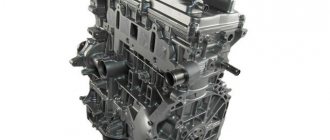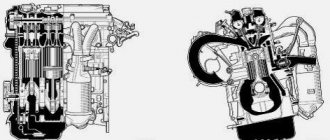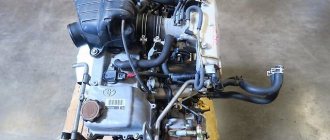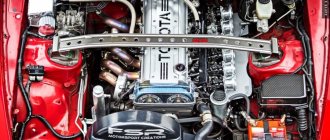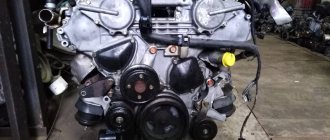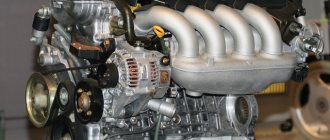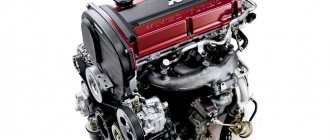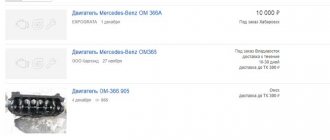The use of engines with low fuel consumption attracts attention with their potential. Any engine is the most significant part, and the ability to overhaul or modernize it is very important. The 2NZ FE power plant is a fairly economical system, its fuel consumption does not exceed 7.2 liters. Although such indicators were achieved by reducing capital costs, the service life of this engine exceeds 200 thousand km.
Technical characteristics of the 2NZ FE engine and its modifications
All engines in the NZ line are 4-cylinder in-line engines with a direct stroke arrangement. Moreover, the cylinder head is made of aluminum alloy. To improve the performance of the 2NZ FE engine, a second generation VVT-i device is used. The gas distribution mechanism is implemented according to the DOHC scheme, and the number of valves per cylinder is 4 pieces. The fuel supply is provided by the SFI sequential injection system, which is highly accurate.
The 2NZ FE engine was the latest modification of the entire NZ series, replacing less economical units. Its production began in 1999 and this model has not lost its relevance for the manufacturer’s plant today. Yamaha's development has its advantages and disadvantages, but the efficiency of such an engine is undeniable. For more compact dimensions, the intake and exhaust valve angles are 33.5 degrees. Unfortunately, most of the design features, although aimed at improving driving characteristics, led to a decrease in the capital level of the entire engine.
Cylinder block 2NZ-FE
The Toyota 2NZ-FE has an aluminum cylinder block with five supports and thin-walled cast iron liners. It has a bore of 75.0 mm and a stroke of 73.5 mm. The engine has a crankshaft with four counterweights and an integrated crankshaft position sensor.
The steel connecting rods for the 2NZ-FE engine have caps that are held in place by plastic area bolts. The engine is equipped with aluminum alloy pistons, semi-floating piston pins and low-voltage rings (two compressor rings and one oil control ring).
| Cylinder block | |
| Alloy | aluminum |
| Compression Ratio | 10,5: 1 |
| Cylinder diameter | 75,0 |
| Piston stroke | 73,5 |
| Piston rings: compression/oil | 2/1 |
| Main bearings | 5 |
| Cylinder inner diameter | 75.000-75.013 |
| Piston skirt diameter | 74,945-74,955 |
| Piston ring side clearance | upper 0.030-0.070 |
| second 0.020-0.060 | |
| oil 0.070-0.150 | |
| Piston ring ring clearance | upper 0.22-0.32 |
| second 0.32-0.47 | |
| oil 0.10-0.35 | |
| Crankshaft journal diameter | 45,988-46,000 |
| Connecting rod diameter | 39,992–40 000 |
Main bearing cap bolts tightening procedure and torque specifications:
- Step 1: 22 Nm; 2.2 kg m
- Step 2: Turn all bolts 90°.
After securing the bearing cap bolts, make sure that the crankshaft rotates smoothly by hand.
Connecting rod bolts
- Step 1: 15 Nm; 1.5 kg m
- Step 2: Rotate the bolts 90°.
Crankshaft pulley bolt
● 128 Nm; 13.0 kg m
Drive plate mounting bolts (A/T)
● 88 Nm; 8.8 kg m
Design features of the 2NZ FE motor
When creating this engine, the manufacturer tried to make its design as light as possible. Light alloy metals were used to make the cylinder block, and the cooling jacket of the power unit has an open design. To ensure greater compactness, the cylinder block itself is made thin-walled and its thickness between adjacent cylinders does not exceed a distance of 8 mm. This design of the engine is considered non-repairable and must be completely replaced after its service life has expired.
- The cooling system for the 2NZ FE engine is liquid type and has a closed circuit. For greater efficiency, forced circulation is used, which shows good results even in difficult working conditions;
- The intake manifold is made of plastic and has elongated pipes to facilitate engine movement. The exhaust manifold has a ball joint and also uses long pipes;
- The timing drive has a single-row chain design with a pitch of 8 mm, which is equipped with a chain tensioner and damper. Its lubrication is carried out by an oil nozzle, and the chain itself is made of particularly durable materials;
- The lubrication system operates according to a full-flow cleaning scheme, and the oil is supplied to the main components and parts under pressure. The oil pump is of the trochoid type, and the oil filter is installed at the bottom next to the sump;
- The ignition system has a DIS-4 classification, which provides its own ignition coil for each cylinder. This design ensures high precision spark supply. Spark plugs on 2NZ FE can be installed with simple or iridium designs.
In general, the engine has a fairly reliable design and will provide good driving performance. In long-term operation, such a motor is less profitable due to the limited resource and the impossibility of carrying out complex overhauls.
Tuning
The 1NZ engine is generally tuned using commercially available ready-made kits, which make it possible to improve its performance characteristics without any problems.
Among them are:
- Standard turbo kit (set of components for tuning 1NZ engines) from TRD, which includes: IHI RHF4 turbine; injectors 2ZZ-GE; fuel pump 1JZ-GTE, etc. Ensure that the engine meets the specified technical characteristics by configuring the electronic control unit 1NZ-FET/GReddy e-Manage Ultimate
- Supercharger kit Blitz, when using which you need to additionally purchase: 2ZZ-GE injectors; thick cylinder head gasket; fuel pump 1JZ-GTE.
By installing the necessary components and correctly setting the engine characteristics using GReddy e-Manage Ultimate, you can get a good high-torque engine for a city car with a power of 145-160 hp. With.
2NZ FE engine maintenance
The design of the Toyota 1.3 liter power engine makes its maintenance quite simple and comes down to basic service operations. The recommended oil change procedure for the 2NZ FE is performed after a mileage of 10 thousand km, but the realities of the roads may require such work to be carried out much earlier. It is quite easy to understand what kind of oil to pour, and the operating manual indicates brands 5W-30 and 10W-30. Excessive oil burn can be caused by various reasons, but in most cases the valve stem seals will need to be replaced.
The timing life of the 2NZ FE engine is 200 thousand km, and separate maintenance of the mechanism should only be performed if problems occur. A broken chain can result in a valve bending situation, requiring a more expensive repair. Attention should also be paid to the air filter, which should be changed twice a year when driving on dusty roads.
Engine 2NZ-FE characteristics, reviews, resource where can I buy?
The famous NZ engine series is available in two variants. The models have four cylinders, the block is covered with aluminum, and there are 16 valves. They were first introduced back in 1999. The models are characterized by a gentle piston stroke and have the same design solutions.
The concern used them for its younger models, the main feature being a significant reduction in fuel consumption. The 2NZ-FE engine is used as the main engine for certain car models. Despite its modest technical characteristics compared to other models, it is ready to produce powerful dynamics and may not be serviced for 100 thousand kilometers.
Engine characteristics
| Production | Kamigo Plant |
| Engine make | Toyota 2NZ-FE |
| Years of manufacture | 1999-present day |
| Cylinder block material | aluminum |
| Supply system | injector |
| Type | in-line |
| Number of cylinders | 4 |
| Valves per cylinder | 4 |
| Piston stroke, mm | 73.5 |
| Cylinder diameter, mm | 75 |
| Compression ratio | 10.5 |
| Engine capacity, cc | 1298 |
| Engine power, hp/rpm | 84/6000 |
| Torque, Nm/rpm | 121/4400 |
| Fuel | 95 |
| Environmental standards | Euro 5 |
| Engine weight, kg | 112 |
| Fuel consumption, l/100 km (for Yaris XP90) - city - highway - mixed. | 7.25.3 6.0 |
| Oil consumption, g/1000 km | up to 1000 |
| Engine oil | 5W-30 10W-30 |
| How much oil is in the engine | 3.7 |
| Oil change carried out, km | 10000 (better 5000) |
| Engine operating temperature, degrees. | ~90 |
| Engine life, thousand km - according to the plant - in practice | n.d.~200 |
| Tuning - potential - without loss of resource | ~150n.d. |
| The engine was installed | Toyota Corolla Toyota Yaris Toyota Vios Toyota bB Toyota Belta Toyota Porte Toyota Platz Toyota Ist Toyota WiLL Vi Toyota WiLL VC |
Technical features of the models
Toyota did not maintain the trend of reducing the volume of power units for long, which was the reason for the infrequent use of 2NZ-FE. Due to this, it ceased to be used in the middle of the last decade. The main technical characteristics of the product include:
- Engine volume – 1.3 liters;
- Produces power of 84 horsepower at 6000 rpm;
- Torque indicator 124 N*m at 4400 rpm;
- 75 mm is the diameter of the cylinder;
- 5 mm piston stroke;
- 5:1 compression ratio.
Fill the tank with at least 92-grade gasoline. The passport allows this option, but owners do not take risks and, as a rule, use a higher level of fuel. After all, poor quality gasoline can cause failure of the sensitive system of the VVT-i fuel mechanism
To obtain the desired dynamics and declared parameters, the owners had to strongly rev up the power unit. Only at 6000 rpm can you really see and evaluate the result.
The use of a timing chain drive brought its own advantages to the design of the motor. At the same time, the owner began to think more often about the need to select the right oil and constantly replace it.
On what cars can the engine be found?
The area of use depends directly on the main characteristic - the minimum volume. You can meet him at
- Funcargo.
- Porte.
- Corolla E140.
- Platz.
Since the machines themselves do not have large parameters, the choice in favor of a small unit is quite justified.
What problems might you encounter?
The 2NZ-FE is largely copied from the old 1NZ model. To achieve an engine rating of 1.3 liters, the developers had to modify the design - reduce the stroke, change the crankshaft, and also use a corresponding cylinder block for the small knee.
In general, experts believe that the engines are not very different, because they have the same problems.
Owners will have to replace certain components, because everyone will encounter knocking, floating speed, breakdown of the fuel sensor, low engine life, general disposability and much more. Like any other unit it has its pros and cons.
Whether it is worth purchasing, everyone will decide for themselves, assessing all the pros and cons. Much depends on the chosen car - if it’s a Toyota Corolla, then it’s a weak option, but if it’s a Yaris, then it’s just right.
Malfunctions of 2NZ FE motors
There are both certain advantages and disadvantages in the operation of the 2NZ FE engine. A car equipped with such a motor will not cause problems for a long time. With proper operation, you can drive at least 200 thousand km. without noticeable problems with the engine. The design of the power plant is reliable enough for city driving or long-distance travel.
However, such characteristics are not without their drawbacks. The small size of the engine and its optimization by the manufacturer make it almost impossible to carry out overhauls, and even more so you should not do it yourself. The small distance between the pistons will not allow boring. The thin timing chain also does not cause delight, although it is capable of working out its entire intended resource.
Characteristics and features of motors
The 2NZ-FE motor has high technical characteristics. The engine has a small volume, which was achieved thanks to the reduced crankshaft stroke to 73.5 mm. There are no other differences from 1NZ-FE.
Toyota Belta with 2NZ-FE engine.
Let's look at the main technical characteristics of 2NZ-FE:
| Name | Characteristics |
| Manufacturer | Kamigo Plant |
| Motor brand | 2NZ-FE |
| Volume | 1.3 liters (1298 cm3) |
| Power | 150 hp |
| Cylinder diameter | 75 mm |
| Number of cylinders | 4 |
| Number of valves | 16 |
| Fuel consumption | 6.0 liters for every 100 km in mixed mode |
| Engine oil | 5W-30 10W-30 |
| Resource | 200+ thousand km |
| Applicability | Toyota Corolla Toyota Yaris Toyota Vios Toyota bB Toyota Belta Toyota Porte Toyota Platz Toyota Ist Toyota WiLL Vi Toyota WiLL VC |
Engine tuning
The increase in power is of particular interest to owners of cars with a small engine capacity.
For NZ series motors it is also possible to increase power by installing a centrifugal compressor. This system is an attachment, and its use does not require registration with the traffic police. There are various modifications of charger kits that can significantly increase engine performance. They can have a disconnectable clutch or be fully integrated into the operation of the internal combustion engine. Although this method does not reach full boost, it allows you to increase power to 145 hp. With.
It is up to the car owner to decide how suitable the engine is for these types of tuning. The design of the 1.3 liter engine has its own characteristics and mechanical modifications can lead to wear of individual parts or the engine itself. Due to the lightweight design of the engine, restoring the power plant may not be practical, and you will have to think about purchasing a replacement for the entire engine.
Engine 2NZ-FE
The NZ series power units are represented by two small-volume four-cylinder engines, an aluminum block and 16 valves. A series of units has been produced since 1999. The motors have a common design, short piston stroke. Designed to save fuel and were installed on younger models of the concern. The 2NZ-FE unit has become the base for some car models. With modest technical parameters, it produced good dynamics and did not require significant intervention during the first hundred thousand mileage.
Model range of cars with the 2NZ FE engine and its modifications
The 2NZ FE engine is installed on a large number of Japanese cars. Such models are well known on the market and enjoy deserved popularity. The most familiar to drivers are the Toyota Corolla and Toyota Yaris, and this list can be continued with the Vios, Belta, bB, Porte, Platz, Ist, WiLL Vi and WiLL VC models.
The NZ engine series has a uniform design across all models with minimal differences. The cylinder block, cylinder head, intake and exhaust manifold and other engine parts are interchangeable. The main differences are changes in the stroke of the crankshaft, cylinder block and related elements. The 2NZ FE motor is the latest modification of the NZ series, which has the following differences:
- The 1NZ-FXE engine is the first generation of engines in this series. It has a cylinder diameter of 75 mm with a piston stroke of 84.7 mm. The high compression of this engine has made it famous and its compression ratio is very high at 13:1. A feature of this engine is the delay in closing the exhaust valves, which increases the potential of the internal combustion engine;
- The 1NZ-FE engine already had a standard valve cycle, and its volume was increased to 1.5 liters. The compression ratio was also returned to the usual levels, and it was already 10.5:1. Production of this power plant began in 2000 and continued until 2007;
- The 2NZ-FE engine has become a real long-liver among the entire NZ line. Its production began in 1999 and continues to this day. Yamaha's development has a volume of 1.3 liters and has low fuel consumption. The operation of the valves is ensured by 2 camshafts, and the motor itself is lightweight and made of aluminum alloys.
Models equipped with a 2NZ FE engine can be found on various roads and their operational reliability allows them to work out their entire service life without critical breakdowns.
Engine characteristics
| Production | Kamigo Plant |
| Engine make | Toyota 2NZ-FE |
| Years of manufacture | 1999-present day |
| Cylinder block material | aluminum |
| Supply system | injector |
| Type | in-line |
| Number of cylinders | 4 |
| Valves per cylinder | 4 |
| Piston stroke, mm | 73.5 |
| Cylinder diameter, mm | 75 |
| Compression ratio | 10.5 |
| Engine capacity, cc | 1298 |
| Engine power, hp/rpm | 84/6000 |
| Torque, Nm/rpm | 121/4400 |
| Fuel | 95 |
| Environmental standards | Euro 5 |
| Engine weight, kg | 112 |
| Fuel consumption, l/100 km (for Yaris XP90) - city - highway - mixed. | 7.25.3 6.0 |
| Oil consumption, g/1000 km | up to 1000 |
| Engine oil | 5W-30 10W-30 |
| How much oil is in the engine | 3.7 |
| Oil change carried out, km | 10000 (better 5000) |
| Engine operating temperature, degrees. | ~90 |
| Engine life, thousand km - according to the plant - in practice | n.d.~200 |
| Tuning - potential - without loss of resource | ~150n.d. |
| The engine was installed | Toyota CorollaToyota Yaris Toyota Vios Toyota bB Toyota Belta Toyota Porte Toyota Platz Toyota Ist Toyota WiLL Vi Toyota WiLL VC |
Characteristics of the 2NZ FE power plant
A description of the technical characteristics of the engine will be conveniently viewed in the table, and to obtain more detailed parameters, you should refer to the service manual.
| Production | Kamigo Plant |
| Engine make | Toyota 2NZ |
| Years of manufacture | 1999 - today |
| Cylinder block material | aluminum |
| Supply system | injector |
| Type | in-line |
| Number of cylinders | 4 |
| Valves per cylinder | 4 |
| Piston stroke, mm | 73,5 |
| Cylinder diameter, mm | 75 |
| Compression ratio | 10,5 |
| Engine capacity, cc | 1298 |
| Engine power, hp/rpm | 84/6000 |
| Torque, Nm/rpm | 121/4000 |
| Fuel | 95 |
| Environmental standards | Euro 5 |
| Engine weight, kg | 112 |
| Fuel consumption, l/100 km | 5,3 — 7,2 |
| Oil consumption, g/1000 km | less than 1000 |
| Engine oil | 5W-30 |
| 10w30 | |
| How much oil is in the engine, l | 3,7 |
| Cylinder operating order | 1-3-4-2 |
| Coolant, capacity, l | 4,4 |
| Oil change carried out, km | 10000 (better 5000) |
| Engine operating temperature, degrees. | 90 |
| Engine life, thousand km | |
| - according to the plant | n.d. |
| - on practice | 200+ |
| Tuning | |
| — potential | 150 |
| - without loss of resource | n.d. |
| The engine was installed | Toyota Corolla |
| Toyota Yaris | |
| Toyota Vios | |
| Toyota bB | |
| Toyota Belta | |
| Toyota Porte | |
| Toyota Platz | |
| Toyota East | |
| Toyota WiLL Vi | |
| Toyota WiLL VC |
For NZ series engines, immunity to critical loads and economical fuel consumption can be noted. Although the engine resource is limited to 200 thousand km, everyone is free to decide on the need for a car with such an engine themselves.
If you have any questions, leave them in the comments below the article. We or our visitors will be happy to answer them
Specifications
The small 2NZ-FE engine hasn't seen too much adoption since Toyota's downsizing trend in powertrains ended in the middle of the last decade. The technical parameters of the engine are as follows:
| Working volume | 1.3 liters |
| Maximum power | 84 horsepower at 6000 rpm |
| Torque | 124 N*m at 4400 rpm |
| Cylinder diameter | 75 mm |
| Piston stroke | 73.5 mm |
| Compression ratio | 10.5:1 |
| Octane number of gasoline | not lower than 92 |
Although the passport allowed filling the 2NZ-FE 92 with gasoline, the owners did not abuse this permission too much. The delicate VVT-i fuel mechanism system could quickly damage the unit if the fuel quality was poor.
The technical characteristics of the 2NZ-FE show that to achieve good dynamics the engine had to be revved up a lot. The unit opened fully only at 6000 rpm.
The timing chain drive brought its advantages to the design, but also made the owner of a car with a Toyota 2NZ-FE engine think about changing the oil more often.
Engine characteristics Toyota 2NZ-FE 1.3 Yaris, Platz
| Parameter | Meaning |
| Configuration | L |
| Number of cylinders | 4 |
| Volume, l | 1,298 |
| Cylinder diameter, mm | 75 |
| Piston stroke, mm | 73,5 |
| Compression ratio | 10,5 |
| Number of valves per cylinder | 4 (2-inlet; 2-outlet) |
| Gas distribution mechanism | DOHC |
| Cylinder operating order | 1-3-4-2 |
| Rated engine power / at engine speed | 64.5 kW - (84 hp) / 6000 rpm |
| Maximum torque/at engine speed | 121 N m / 4400 rpm |
| Supply system | electronic fuel injection system EFI, distributed injection |
| Recommended minimum octane number of gasoline | 92 – for models of the domestic Japanese market; 95 – for foreign market models |
| Environmental standards | Euro 4, Euro 5 |
| Weight, kg | 77.8 (A/T); 83.2 (M/T) |
